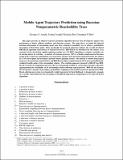| dc.contributor.author | Aoude, Georges | |
| dc.contributor.author | Joseph, Joshua Mason | |
| dc.contributor.author | Roy, Nicholas | |
| dc.contributor.author | How, Jonathan P | |
| dc.date.accessioned | 2018-04-23T20:01:38Z | |
| dc.date.available | 2018-04-23T20:01:38Z | |
| dc.date.issued | 2011-03 | |
| dc.identifier.isbn | 978-1-60086-944-0 | |
| dc.identifier.uri | http://hdl.handle.net/1721.1/114899 | |
| dc.description.abstract | This paper presents an efficient trajectory prediction algorithm that has been developed to improve the performance of future collision avoidance and detection systems. The main idea is to embed the inferred intention information of surrounding agents into their estimated reachability sets to obtain a probabilistic description of their future paths. More specifically, the proposed approach combines the recently developed RRT-Reach algorithm and mixtures of Gaussian Processes. RRT-Reach was introduced by the authors as an extension of the closed-loop rapidly-exploring random tree (CL-RRT) algorithm to compute reachable sets of moving objects in real-time. A mixture of Gaussian processes (GP) is a flexible nonparametric Bayesian model used to represent a distribution over trajectories and have been previously demonstrated by the authors in a UAV interception and tracking of ground vehicles planning scheme. The mixture is trained using typical maneuvers learned from statistical data, and RRT-Reach utilizes samples from the GP to grow probabilistically weighted feasible paths of the surrounding vehicles. The resulting approach, denoted as RR-GP, has RRTReach's benefits of computing trajectories that are dynamically feasible by construction, therefore efficiently approximating the reachability set of surrounding vehicles following typical patterns. RRT-GP also features the GP mixture's benefits of providing a probabilistic weighting on the feasible trajectories produced by RRTReach, allowing our system to systematically weight trajectories by their likelihood. A demonstrative example on a car-like vehicle illustrates the advantages of the RR-GP approach by comparing it to two other GP-based algorithms. © 2011 by Professor Jonathan P. How, Massachusetts Institute of Technology. Published by the American Institute of Aeronautics and Astronautics, Inc. | en_US |
| dc.publisher | American Institute of Aeronautics and Astronautics (AIAA) | en_US |
| dc.relation.isversionof | http://dx.doi.org/10.2514/6.2011-1512 | en_US |
| dc.rights | Creative Commons Attribution-Noncommercial-Share Alike | en_US |
| dc.rights.uri | http://creativecommons.org/licenses/by-nc-sa/4.0/ | en_US |
| dc.source | MIT Web Domain | en_US |
| dc.title | Mobile Agent Trajectory Prediction using Bayesian Nonparametric Reachability Trees | en_US |
| dc.type | Article | en_US |
| dc.identifier.citation | Aoude, Georges, et al. "Mobile Agent Trajectory Prediction Using Bayesian Nonparametric Reachability Trees." Infotech@Aerospace 2011, 29-31 March, 2011, St. Louis, Missouri, American Institute of Aeronautics and Astronautics, 2011. | en_US |
| dc.contributor.department | Massachusetts Institute of Technology. Department of Aeronautics and Astronautics | en_US |
| dc.contributor.mitauthor | Aoude, Georges | |
| dc.contributor.mitauthor | Joseph, Joshua Mason | |
| dc.contributor.mitauthor | Roy, Nicholas | |
| dc.contributor.mitauthor | How, Jonathan P | |
| dc.relation.journal | Infotech@Aerospace 2011 | en_US |
| dc.eprint.version | Author's final manuscript | en_US |
| dc.type.uri | http://purl.org/eprint/type/ConferencePaper | en_US |
| eprint.status | http://purl.org/eprint/status/NonPeerReviewed | en_US |
| dc.date.updated | 2018-03-22T13:23:59Z | |
| dspace.orderedauthors | Aoude, Georges; Joseph, Joshua; Roy, Nicholas; How, Jonathan | en_US |
| dspace.embargo.terms | N | en_US |
| dc.identifier.orcid | https://orcid.org/0000-0002-8293-0492 | |
| dc.identifier.orcid | https://orcid.org/0000-0001-8576-1930 | |
| mit.license | OPEN_ACCESS_POLICY | en_US |
